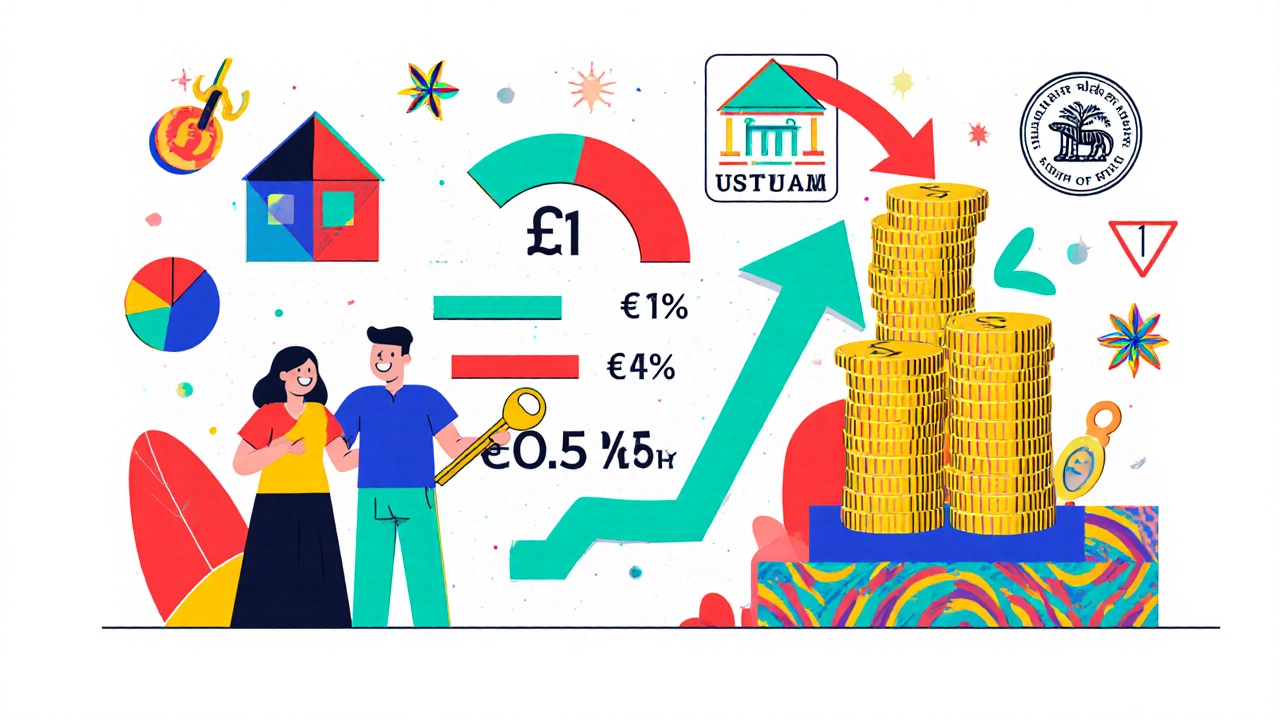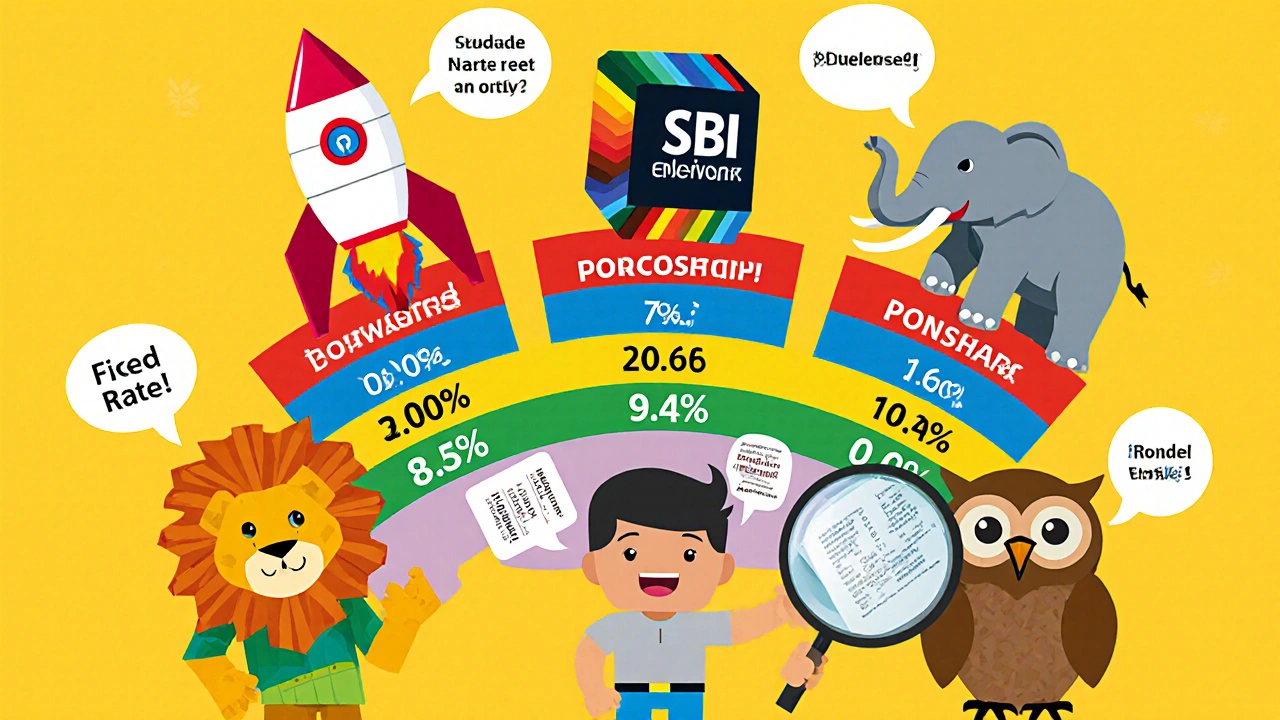Home Loan Interest Rates in India: How They Work and How to Get the Best Deal
 Nov, 22 2025
Nov, 22 2025
When you’re buying a home in India, the interest rate on your loan isn’t just a number on a paper-it’s the biggest factor that decides how much you’ll pay over 20 years. A 0.5% difference might seem small, but it can cost you over ₹5 lakh extra on a ₹50 lakh loan. That’s not a typo. That’s real money. And most first-time buyers don’t even know how to compare rates properly.
How Home Loan Interest Rates Work in India
Indian banks and housing finance companies use two main types of interest rates: fixed and floating. Fixed rates stay the same for the entire loan term or a set period-usually 3 to 5 years. Floating rates change with the market, tied to the RBI’s repo rate or the lender’s Marginal Cost of Funds-based Lending Rate (MCLR).
As of November 2025, floating rates are averaging between 8.25% and 9.5%, depending on your credit score, loan amount, and lender. Fixed rates are higher, usually between 9% and 10.5%. Why? Because lenders charge more to lock in your rate and protect themselves from rising market rates.
The RBI doesn’t set home loan rates directly, but it controls the cost of money for banks. When the repo rate goes up, banks borrow more expensive money from the central bank-and they pass that cost to you. In 2024, the repo rate hit 6.5%, and by mid-2025, it stayed steady. That’s why floating rates have stabilized around 8.5% for top borrowers.
What Affects Your Home Loan Interest Rate?
Your rate isn’t random. Lenders look at five key things:
- Credit score: If your CIBIL score is below 700, you’ll pay at least 0.75% more. With a score above 780, you qualify for the lowest rates.
- Loan-to-value ratio (LTV): If you’re borrowing 80% of the property value, you get better rates. Borrowing 90%? Expect higher rates and mandatory insurance.
- Income stability: Salaried employees with 3+ years in the same company get better terms than freelancers or new entrepreneurs.
- Loan tenure: Longer tenures mean lower EMIs but more total interest. A 30-year loan costs nearly 2.5x more in interest than a 15-year loan.
- Property type: Ready-to-move-in apartments get lower rates than under-construction projects. Banks see completed homes as lower risk.
For example, a 32-year-old software engineer with a ₹15 lakh annual income, a CIBIL score of 810, and a 75% LTV on a ₹75 lakh apartment in Pune got a rate of 8.35%. Her friend, a self-employed graphic designer with a 720 score and 90% LTV on a ₹60 lakh plot in Jaipur, got 9.4%.
Where to Find the Best Home Loan Rates
Don’t just go to the bank your salary account is with. The best rates are often offered by non-bank lenders or newer digital platforms.
In 2025, the top five lenders for lowest home loan rates were:
- HDFC Bank - 8.25% for salaried with score >780
- Axis Bank - 8.30% with pre-approved offers
- ICICI Bank - 8.35% with bundled insurance
- State Bank of India - 8.40% for government employees
- Edelweiss Housing Finance - 8.15% for high-income professionals (₹20L+)
Some fintech lenders like MoneyTap and ZestMoney offer rates as low as 8.05% for borrowers with strong digital footprints-consistent UPI usage, regular savings, and no missed EMIs in the last 12 months.
Compare rates on BankBazaar or Policybazaar, but always check the fine print. Some lenders advertise low rates but add hidden charges like processing fees, legal fees, or insurance commissions.

How to Negotiate a Lower Rate
You don’t have to accept the first rate offered. Here’s how to negotiate:
- Get pre-approved offers from 3+ lenders. Show them to your preferred bank-they’ll often match or beat the lowest.
- Ask for a rate discount if you’re willing to buy insurance or a locker from them.
- Offer to link your salary account or invest ₹5 lakh in mutual funds with them.
- Use your existing relationship: if you’ve had a car loan or credit card with them for 3+ years, mention it.
- Ask for a 0.1% to 0.3% reduction for a longer tenure. It’s cheaper for them to lock you in longer.
One buyer in Bengaluru reduced her rate from 8.7% to 8.3% just by showing a pre-approved offer from HDFC and asking for a waiver on the ₹15,000 processing fee. That saved her ₹1.8 lakh over the loan term.
Hidden Costs That Make Rates Look Better Than They Are
Low rate? Great. But if you’re paying ₹25,000 in processing fees, ₹10,000 in valuation fees, and ₹12,000 for mandatory insurance, your real cost is higher.
Always calculate the effective interest rate-this includes all fees. A 8.3% rate with ₹50,000 in charges is effectively 8.9%. Use an EMI calculator with fees included.
Also watch out for:
- Prepayment penalties: Most lenders removed these after 2020, but check your agreement.
- Conversion fees: Switching from fixed to floating later can cost ₹10,000-₹25,000.
- Foreclosure charges: Some NBFCs still charge 2-3% if you pay off early.
Ask for a written breakdown of all charges before signing. If they hesitate, walk away.
When to Choose Fixed vs Floating Rate
Here’s the simple rule:
- Choose fixed if you’re risk-averse, on a tight budget, or expect interest rates to rise in the next 3-5 years.
- Choose floating if you have savings to absorb rate hikes, plan to prepay early, or believe the RBI will cut rates soon.
In 2024, many borrowers switched from fixed to floating after the RBI signaled rate cuts. By mid-2025, those who stayed on floating saved ₹8-12 lakh on 20-year loans.
But if you’re buying your first home and your salary is barely covering the EMI, fixed gives you peace of mind. You won’t get shocked if rates jump to 9.5% in Year 4.

How to Lock in the Best Deal Before You Sign
Here’s your checklist before signing the loan agreement:
- Confirm the interest rate is in writing-no verbal promises.
- Check if the rate is linked to MCLR or Repo Rate. Repo-linked is more transparent and responsive.
- Ask for a sample amortization schedule showing EMI, interest, and principal for the first 12 months.
- Verify if there’s a cap on how high the floating rate can go (most don’t, but ask).
- Get a no-obligation letter of approval with all terms listed.
- Never pay any fee before the loan is approved.
One buyer in Hyderabad lost ₹3 lakh because he paid a ₹50,000 booking fee to a broker who promised a 7.9% rate. The actual loan came at 9.2%. He had no written proof.
What to Do After You Get the Loan
Getting the loan is just the start. To truly save:
- Make one extra EMI every year. On a ₹50 lakh loan at 8.5%, that cuts 3 years off your term and saves ₹11 lakh in interest.
- Use your bonus or tax refund to prepay. Even ₹1 lakh extra reduces your total interest by ₹2.5 lakh.
- Switch to a lower rate if your credit score improves. Many lenders let you refinance for free if your score jumps above 780.
- Don’t forget to update your property insurance. Outdated policies can void your loan terms.
People who prepay even ₹5,000 a month on their home loan end up owning their house 7-10 years earlier. That’s not just saving money-it’s gaining freedom.
What is the lowest home loan interest rate in India right now?
As of November 2025, the lowest home loan interest rate available is 8.05%, offered by select fintech lenders like Edelweiss Housing Finance and MoneyTap to high-income professionals with strong digital credit histories. Traditional banks like HDFC and Axis offer rates starting at 8.25% for borrowers with CIBIL scores above 780 and low loan-to-value ratios.
Is a fixed or floating interest rate better for home loans in India?
Floating rates are usually better if you plan to prepay early or expect interest rates to fall. Most home loan borrowers today choose floating because rates have stabilized after the RBI’s 2024 rate hikes. Fixed rates are safer if your budget is tight and you can’t afford sudden EMI increases. But fixed rates are typically 0.7%-1% higher than floating.
Can I negotiate my home loan interest rate?
Yes, and you should. Lenders expect it. Get pre-approved offers from 3 lenders and use them as leverage. Offer to link your salary account, buy insurance, or invest a small amount with them. Many borrowers reduce their rate by 0.1% to 0.4% just by asking. Always get the final rate in writing.
How does my credit score affect my home loan rate?
Your CIBIL score is one of the biggest factors. A score below 700 can add 0.75% to 1.25% to your rate. With a score of 750-779, you get standard rates. A score above 780 qualifies you for the lowest rates available. Check your score at least 3 months before applying-fix errors and pay down credit card balances first.
Are there any hidden costs in home loans I should watch out for?
Yes. Processing fees (₹10,000-₹50,000), legal and valuation fees (₹5,000-₹15,000), insurance commissions, and prepayment penalties (though rare now) can add up. Always ask for a written breakdown of all charges. The advertised interest rate doesn’t include these. Calculate the effective rate by adding fees to the total loan cost.
Should I refinance my home loan if I find a better rate?
If your current rate is above 8.5% and you’ve improved your credit score or income, refinancing can save you lakhs. Most lenders now waive foreclosure charges. But check the new loan’s total cost-including processing fees and insurance. If you’ve already paid 5+ years of EMIs, the savings might not justify switching. Use a refinance calculator first.
Final Tip: Don’t Just Chase the Lowest Rate
The lowest interest rate isn’t always the best deal. A lender with a 0.2% lower rate but a 30-day approval delay, poor customer service, or hidden fees might cost you more in time and stress.
Look for lenders with:
- Fast digital processing (under 7 days)
- Free EMI moratorium options
- Easy prepayment policies
- Good customer reviews on Trustpilot or Google
Homeownership is a 20-year journey. Pick a lender you can trust-not just the one with the cheapest rate today.
